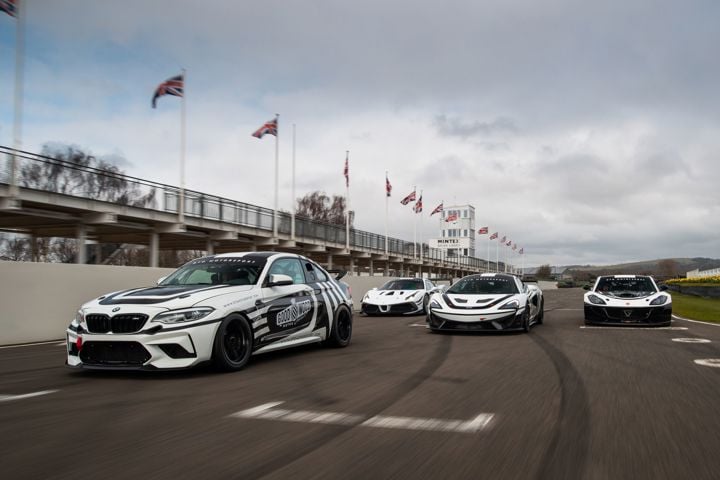Doug Nye: Celebrating the 1950s upstarts
 Doug Nye
Doug Nye
Obscurity. That’s the name of the game. I have always had a great interest in the unusual, the off-beat, the out of the ordinary. Why be interested in the ordinary – when there’s plenty out there that is absolutely extraordinary.

Sometimes that level of being extraordinary is matched by extraordinary optimism, extraordinary incompetence and associated lack of success. But – hey – never mind. Plenty of stories of failure are way more entrancing and intriguing than tales of success, fame and fortune…
Just having another look through our old Goodwood photo files and what springs to light? Jack Fairman driving the Turner single-seater at Goodwood in 1954. Welsh engineer Jack Turner (1916-2011) built his first cars at The Old Smithy in Seisdon, South Staffordshire, before moving around 1953 into a workshop at 32 Merridale Street, Wolverhampton. By 1956 Turner moved again, that time to nearby Pendeford aerodrome where the marque’s cars would continue to be manufactured until the enterprise folded early in 1966.
It was in 1954 that Jack Turner launched his “entry-level” sportscars. They went on to provide a first step into club racing – and higher-level competition – for all kinds of enthusiasts, and with a variety of engines such as BMC A-series, Coventry Climax and Ford they could keep the proud owner-drivers of much more costly and exotic machinery really honest in their racing activities. One car, the ‘Tatty Turner’ campaigned by Pat Fergusson was particularly potent, and very successful in British club racing in the early 1960s.

Mackenzie-Low’s Turner team sports car receiving attention in the Goodwood pits
Turner had launched his business after being attracted by Cooper’s idea of producing a kit car to accept MG power. He built himself a similar twin-tube chassis frame with transverse-leaf independent suspensions fore and aft and once fellow enthusiasts expressed an interest in another one just like that please, he was up and running.
Turner was then approached by private owner/racing driver John Webb to convert his ex-Reg Parnell MG K3 Magnette into a single-seater. It was powered by a unique twin-cam headed MG engine converted by Laurence Pomeroy. Now Turner further developed this engine and Webb – suitably impressed – ordered an all-new unsupercharged 2-litre Formula 2 car for the 1953 season.
One of Turner’s earliest sportscar customers had been Ken Rose, whose father Hugh had been chief engineer of Lea-Francis. Through this connection, Turner acquired a 1767cc Lea-Francis engine recast in aluminium instead of the standard iron, which made the ‘Leaf’ engine horribly heavy. Enlarged – like Connaught’s similar power units – to 1960cc, fitted with twin-plug ignition and later even an early fuel-injection system, Turner eventually claimed 145bhp at 6,000rpm from this engine. It was mounted in the car driving to an Armstrong-Siddeley pre-selector gearbox and chassis-mounted ENV differential. The chassis was lozenge-shaped – like the sportscars – with transverse-leafspring suspension at either end, Girling drum brakes and Turner cast-alloy wheels.

Paul Emery in the Equipe Anglaise Cooper-Alfa Romeo - Goodwood assembly area
John Webb campaigned the neatly-bodied little car in minor British Formula 2 races, and in 1954 fitted a 2 ½-litre Alta engine for the jump into the then-new Formula 1. Jack Fairman drove in the International Trophy race at Silverstone – finishing sixth in Heat – but the car was not very reliable and on one occasion poor Webb upended it at Crystal Palace. But it was also a Goodwood runner – not a star turn but unique – and of course, out of the ordinary…
Now while Cooper produced its chassis and body components as kit cars for special builders to adopt whatever power unit and driveline they might fancy, their ‘standard’ unsupercharged 2-litre Formula 2 car for 1952-53 would be the Cooper-Bristol – with 6-cylinder Bristol engine mounted up front. Of course, Mike Hawthorn made his name in one of the cars through 1952 and earned himself a maiden Grand Prix-winning works drive with Ferrari the following year.
But several owners either thought they could do better than a Bristol engine or cheaper – just following the same Cooper chassis/body recipe but with horsepower from a different source. In 1952, Mike Hawthorn’s wonderfully successful Cooper-Bristol had been owned by Bob Chase – owner of a large engineering company based in Brighton, Sussex. When Mike moved on for 1953 Bob Chase joined with Cooper-Bristol driver Alan Brown to form Equipe Anglaise. This little team then commissioned special builder and 500cc Formula 3 car constructor Paul Emery to build-up a Cooper T23 or Mark II front-engined chassis into which they inserted a modified Alfa Romeo 1900 4-cylinder engine. Sadly, the new car proved a rolling disaster – Brown temporarily split from Chase and acquired the ex-Bobby Baird Cooper-Bristol to keep racing. Once Brown and Chase were reunited, the Cooper-Alfa – much unloved – had its engine replaced by a conventional Bristol 6-cylinder unit, and they could race more sensibly with that.

The Cooper-Alfa Romeo seemed to spend more time being pushed than motoring under its own steam…as here on the Goodwood pit straight
Cooper chassis from the same family also appeared fitted with Alta 4-cylinder engines in numerous guises, and Peter Walker and Peter Whitehead also raced a Cooper-ERA which proved rather too long-chassised, and too nose heavy, to be a sensibly controllable proposition – loads of horsepower, but excessive understeer being the order of the day. Pretty much like the 2-litre Alta single-seater in the last Revival Meeting… in the wet. Turn right around Madgwick, or straight on through the bank heading for Chichester – that was the question.
And it’s all a case of seeking out the unusual and the extraordinary – because somewhere back then the scenario would always feature an enthusiastic optimist… might I suggest, just like us?
Photography courtesy of The GP Library
Doug Nye





